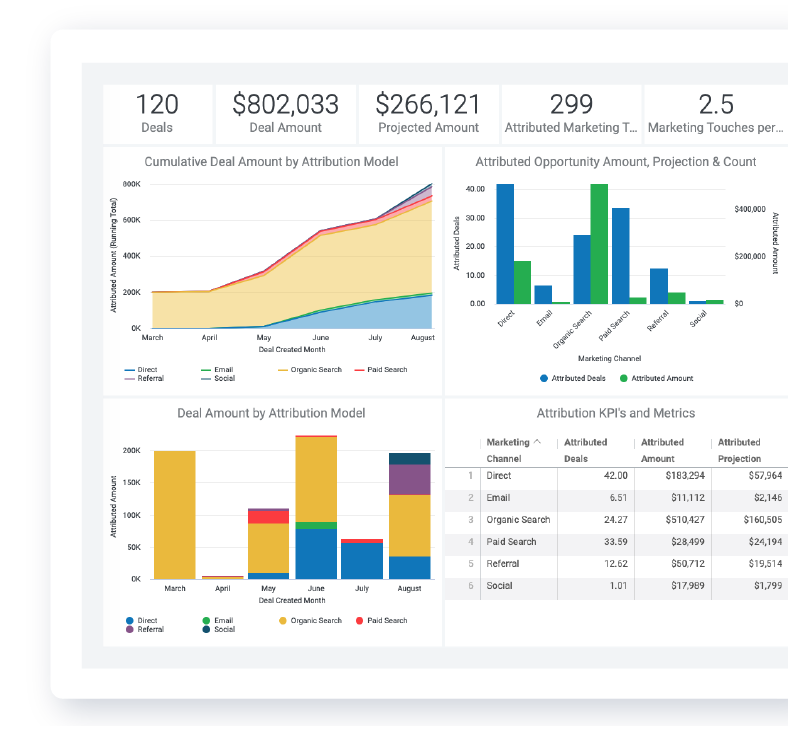Marketing Attribution
By embracing DemandJumps approach to SEO, we have been able to increase our organic rankings within just 2 weeks of implementing recommendations. This helped us see a 22% increase in organic search month-over-month.
Robert Jacko Vice President Digital Marketing @ Homage
DemandJump has become a crucial extension of our marketing team, providing game changing insights to fuel and propel all aspects of our digital marketing efforts. The DemandJump platform is a must have, we are seriously impressed.
Tim Lavinder Director of Ecommerce @ Hotsox
We used to spend hours looking for insights in dozens of tools and reports. Now we log into one place to find out what customers are doing and how to meet them where it matters most.
Zach Roop Digital Marketing Manager @ Dometic
We use DemandJump recommendations as our digital to-do list. We love going in and seeing the recommendations and knowing what to do next.
JoLynda Wilson Marketing Director @ IWC
Our Customers Love Attribution






Account-Based Attribution
Eliminate wasted time and spend. With DemandJump's automated account-based attribution
solution you will know with certainty which efforts are driving ROI.
Measure Your Marketing Performance
Find out which of your marketing efforts are making the biggest impact. See which channel drove consumers to you, the pages they visited, and all touchpoints along their path to purchase.

From Marketing Spend to Actual Pipeline Value
When a lead becomes a customer, you need to know which marketing channel or campaign should receive credit, and account-based attribution will give you the answers.

Organic & Paid Search Keyword Attribution
Beyond channel, campaign, and content attribution, you will finally see which organic and paid keywords are generating deal and opportunity revenue.

See a Demo of Attribution
Mobile Attribution
Are you able to prove which marketing campaigns and keywords influence each sale and generate the best return on investment (ROI)?
In the past, you could consider that the power in the relationship between a marketer and the consumer was with the marketer because they could control the information spread about their products with print advertising, radio or television to broadcast their marketing messages. All that has changed since the onset of digital marketing. With the increasing complexity of digital behavior and media to consume, the power now rests with the consumer which means innovative marketers need to use advanced technologies to track the consumer during their entire journey identifying which marketing efforts, ad campaigns, and keywords deliver the best ROI.
Digital marketing experts estimate that most Americans are exposed to around 4,000 - 10,000 advertising messages a day. In today's digital world, consumers can quickly use their mobiles to research products and services - allowing them to make more informed buying decisions than ever before. The challenge for marketers is how can you meet the consumer at the right time, with the right message, using the marketing channels they prefer to use along their buying journey. There is a solution, adopting cross-channel analytics solutions with more advanced multi-touch attribution for mobile.
DemandJump removes the blindspots from marketing by revealing more of the customer journey and competitive landscape than you could ever see before. With the platform’s market intelligence, cross-channel analytics, marketing attribution, and channel optimization, you will be able to uncover exactly what influences the consumer to make a purchasing decision. You can track what they are doing throughout their entire journey including the websites they visit, the searches they make and the questions they have from awareness to decision mode.
A critical aspect of developing an effective marketing strategy is knowing which campaigns work the best. This is often done by assigning credit to different marketing touchpoints by using various attribution models to analyze and optimize your marketing spend. When armed with these insights, you can allocate resources more effectively to acquire new customers and lead them to purchase. Yet despite this, many marketers are flying blind by not properly assigning credit to all touchpoints along the customer journey. Using marketing attribution tools, it gives you real-time specific insights into what works and what doesn’t. Using analytic software such as a multi-touch attribution model helps you stay abreast of consumer trends to instantly identify opportunities you can leverage for a successful campaign.
What Does Attribution Mean in Marketing?
Marketing attribution is the practice of evaluating all the marketing touchpoints a consumer encounters on their path to purchase. Marketing attribution helps you understand what your customers want, when they want it and leads to the creation of smarter marketing campaigns. By understanding how different interactions affect movement along the customer journey, attribution makes it easier to prioritize what marketing channels to use and highlight what messages are the most effective in converting the sale.
The goal of attribution is to determine which channels and messages had the greatest impact on the consumer's decision to convert or take the next step. However, as more marketers begin to run multiple cross channel campaigns, it gets trickier to measure the ROI for each one. For instance, a consumer's journey who discovers your brand via instagram may look very different than someone who discovers your brand through organic search. Understanding the differences, and how these two marketing channels work together to move consumers down the funnel is key to optimizing your campaigns. Marketers need to embrace multi-touch attribution models to cross-channel campaigns to effectively manage, optimize and scale the performance.
Two critical questions marketers need to ask are “How much does an ad campaign really influence prospects?” and “How does one channel compare against another?” The answers to these questions using attribution tracking allow you to make smarter adjustments to your marketing tactics.
The benefits of using multiple attribution models include:
- Learn which channels your customers use to enter the funnel and which ones they convert from.
- Analyze historical attribution data, allowing you to invest in the channel that brings you buyers and not just create awareness.
- Quantify the ROI and revenue impact of every channel at each stage of the marketing funnel
What is an Attribution Model?
An attribution model refers to the method through which the “credit” of a conversion is distributed among marketing touchpoints. In essence, attribution models work by assigning points to certain marketing channels. When someone buys from you, a marketing channel gets one or part of a point split amongst a few channels. Because there are numerous attribution models on the market, and no one attribution model is “right” per se, the benefit of attribution comes down to how you use it to measure:
- The influence message sequencing had on the consumer's decision to purchase.
- The types of messages a consumer was exposed to and on what channels using what devices
- Which messages and creative imagery got the best results
- Which touchpoint had the greatest impact on their decision to purchase
- The role brand perception played in the decision to convert the sale
It’s important to use an attribution model that suits your current marketing strategy the best. Before picking a marketing attribution model, you should be able to articulate the intentions of your marketing campaigns. Are they to generate new leads? To evaluate this strategy, you might use a first-click attribution model. Are you trying to more efficiently convert customers at the bottom of the funnel, you may use a last-click attribution model to do this. Although there are dozens of possible attribution models suited to PC and mobile devices, they can generally be narrowed down into three categories.
- Single-Touch which includes first/lead creation touch and last/opportunity conversion touch).
- Multi-touch attribution which includes W and U shape conversion.
- Full-Path which includes post opportunity stage marketing).
Single-Touch Attribution Models
Single-touch attribution is the practice of attributing revenue to one specific touchpoint along the customer journey. Single-touch attribution models give 100% of the credit from a consumer's purchase to the first-click or last-click or corresponding keyword. Let's a consumer interacts with your awareness-level Facebook ad, then a Google-branded search ad, followed by an abandoned cart email, the first-touch attribution would give 100% of the credit to the Facebook ad whereas a last-touch attribution would give 100% of the credit to the email and no credit to the Google ad.
Although the first-touch attribution model overemphasizes top-of-the-funnel marketing channels that drive awareness and for this reason, single-touch attribution models are less widely used today as they fail to provide a nuanced look at the complete customer journey. A single-touch attribution approach neglects to look at the entire customer journey and each touchpoint they engage with.
The first-touch attribution assumes the consumer gives full credit to the first touchpoint regardless of any additional messages they may have seen subsequently. Marketers should avoid relying solely on single-touch attribution models. Last-touch undervalues any awareness generated by marketing touchpoints from blog posts, social media, or other influential marketing messages. These channels play a huge part in building your brand and are a valuable component of any marketing strategy.
These single-touch attribution models are helpful at identifying where your marketing initiatives fit in the marketing funnel, but they do little to effectively articulate the holistic value of each marketing touch. However, when compared side by side, or in conjunction with an algorithmic attribution model, marketers can better understand where to invest their marketing budgets to optimize revenue generation.
Multi-Touch Attribution
According to Salesforce, on average it takes 6 to 8 marketing touches to generate a viable sales lead and 60% of the sales cycle is over before a consumer talks to a salesperson. So relying solely on a single touch attribution model often neglects 6 to 7 other important points along the customer journey.
Unlike single-touch attribution models, a multi-touch attribution model takes into account all the touchpoints the consumer engaged with leading up to their decision to purchase. Using a multi-touch model is considered to be more accurate depending on which multi-touch model you use. The different models are largely differentiated by how they divide credit between touchpoints on the path to purchase. Some multi-touch attribution models will assign value based on when a consumer interacted with a touchpoint relative to the conversion, while others weigh up all touchpoints equally.
There are three main multi-touch attribution models you should consider when it comes to mobile apps, the U-shape which gives credit to both the first marketing touchpoint and to the lead conversion touchpoint. The second is the W-shaped attribution model which is more effective because it splits revenue credit three ways between the first-touch, the lead-conversion touch, and the opportunity-creation touch. By handing out the credit equally, it allows your marketing team to uncover exactly where their activities are creating the most impact, because it’s properly distributing the credit to each key touchpoint within the funnel. The third and most effective is the ‘full path’ attribution model, where revenue credit can be assigned from view-through initiatives all the way to the customer purchase.
Full-Path Attribution
The full-path marketing attribution model is one of the more sophisticated rule-based attribution models available in the market today. Full-Path attribution models are also known as a Z-Shape giving you a deep dive into the intricacies of attribution modeling. In addition to the three key touchpoints that W-shaped attribution modeling tracks, a full-path model also includes the customer-close touchpoint. This includes post-opportunity stage marketing initiatives in the attribution model as it incorporates sales activities into the overall marketing mix. Armed with this insight, it allows sales team’s to follow up interactions which can be measured in sync with touchpoints from marketing activities as well. If your marketing campaign is targeted at people who are already in the sales pipeline, then you should consider using the full-path attribution model for both PC and mobile.
What is Mobile Attribution?
We live in a multi-device world where a consumer might have a smartphone, tablet, work computer, home computer and even smart home devices like Alexa. The problem for marketers is that each of these devices might throw data as a unique visitor when in fact they are the same consumer using different devices. Your users will come from multiple advertising channels. So, if you can’t track the how, who, when and why of their journey to a mobile app, you won’t know which of your channels are delivering users. Nor will you understand the relative value of those users or how much of your marketing budget is going directly towards click spam and click frauds.
Mobile app attribution gives you the ability to identify how and where users learn about your app. This allows you to map interactions across platforms. Ultimately, this lets you monitor and optimize the entire customer journey by collecting mobile data to give you greater insights into what led a user to install your app. One of the greatest benefits of mobile attribution is that it gives you the ability to figure out exactly what caused a rise or fall in app installations.
A mobile attribution provider gives you a platform to discover if a user arrived in your app via a video for instance, which enables you to understand how that user moved through your app which means you can compare their journey to another consumer using a different source. Once you’ve determined which are your best-performing campaigns, and pinpoint the most effective ads, a mobile attribution app gives you relevant feedback to optimize your creative assets and use hard data to eliminate ads that aren’t working.
Greater knowledge about how your ads perform on mobile apps allows you to build targeted marketing campaigns and smart retargeting activities when consumers abandon their carts. For example, you could specifically target users who tried out your app but didn’t stick around to make it work from them.
Working with a mobile app attribution provider gives you a helicopter view over your data with a single streamlined dashboard you can utilize for in-depth analysis without having to collate or wrangle data from any of your media partners. A good mobile attribution app will give you the power to verify purchases and should come with fraud protection to make sure your data stays clean and reliable.
How Does Mobile App Tracking Work?
Mobile app attribution across channels typically involves advanced technologies such as universal deep linking, fingerprinting, and secure postbacks for data sync. General mobile app attribution methods include:
- A unique identifier matching where real-time comparisons are made between automated clicks to installs.
- Device fingerprinting by collecting publicly available data on the mobile device to create a unique fingerprint. This is then used for further attribution of an app install to a specific channel.
- An Open URL with Click ID where a click creates a Tracking ID and turned into the conversion request for an install or event. The conversion is then assigned to the advertisement source associated with the click.
- A unified attribution solution where it integrates various methods of mobile app download tracking creating a unified solution for attributing app-to-app installs and mobile web-to-app installs.
When a consumer clicks a link taking them to the app store, by downloading the mobile app and opening it for the first time, the attribution provider will receive the following data points:
- Advertising ID - generating a string of numbers and letters used to uniquely identify every smartphone or mobile device globally.
- IP address – refers to a the unique code used to identify computers - short for “Internet Protocol”
- User agent – generates a line of text that identifies a user’s browser and operating system.
- Timestamp – logs the time that a consumer first clicked on the link.
- First Install - this is activated when the app is first opened.
Once a user’s mobile app installation is confirmed, the attribution provider begins to look at any past engagements with advertisers and attempts to make a match. With this information, the attribution provider can determine whether the user is new or existing. If the user is new, the attribution provider will attempt to match the user’s install to their engagement with a particular ad or series of marketing touches. This exchange of information can happen in several ways; the most common is for the app to integrate the attribution provider’s Software Development Kit (SDK).
A quality mobile app tracking tool gives you a stream of real-time data and analytics coming directly from the app in the form of comprehensive reports making monitoring easier and more effective. To track mobile apps, a small piece of code is inserted into the app allowing it to communicate with a server, send data from the app which is then used for attributing downloads and installs to the links consumers clicked on. Once a tracking code is installed into a mobile device app, you can then use the data to augment the bottom of your conversion funnel by measuring registrations, tracking in-app purchases, and other mobile app events.
Android vs. iOS Mobile apps
Google Analytics provides a free mobile tracking app that makes marketers of android apps lives way easier. It allows them to use referrer URL parameters in download links to the App Play Store. This means an install can be registered and associated with further page views and app events. However, when it comes to tracking iOS mobile apps, attribution becomes more complicated. Apple still doesn’t provide a built-in attribution mechanism which means marketers are deprived of the possibility of tracking in-app events within Apple App Store Analytics.
API Integrations
In choosing a multi-touch attribution model, always ensure an Application Program Interface (API) integration function is available so that software can interact with each other. Applying an API integration solution into your mobile app secures a seamless data flow between two applications. Advanced, multi-touch attribution solutions are equipped with these types of integrations between multiple ad platforms, marketing automation programs, optimization applications, live chat systems, and many others.
Since you already know consumers interact with multiple channels and mobile devices across their buying journey, a multi-touch attribution solution for mobile should be able to track and assimilate data from those same channels and platforms. Without API integrations, a multi-touch attribution solution wouldn’t be able to capture the complete buying paths for users and accounts. Garbage in, garbage out. Without a comprehensive seamless flow of data, data integrity would be easily compromised.
Choosing a Mobile Attribution Provider
Marketing engagement analytics involves combining mobile business and app use insights with mobile app attribution to help marketers better understand and optimize sources of real value. In saying that, It’s important to know which media sources, retargeting networks, third-party analytics platforms, and marketing automation providers offer. Your mobile app attribution platform needs to collect its own data, not using a mobile app attribution platform that aggregates data that ad networks provide to ensure the integrity of the data collected. You must also select a platform that is GDPR compliant and follows industry security standards.
Since choosing the right mobile app tracking platform is a must for your mobile marketing strategy, take time to thoroughly research all obtainable data and analytics on any third-party mobile attribution tools. Budget is only one consideration because often you get what you pay for. Be sure to choose a workable multi-touch attribution for mobile that best suits your needs and supports your marketing goals and objectives.
With the right attribution tools, you can be confident you will make good marketing decisions that will give you the best ROI. Using multi-touch campaign best practices means you will always give credit to the touchpoint where credit is due. It is the most accurate way to track all of your marketing efforts back to revenue, aligning both your sales and marketing team objectives.
Choosing an attribution model can be confusing. With DemandJump as your partner, you can be confident that you are always making the right marketing decisions for your business. Request a demo to understand more about using attribution methodology in your marketing campaigns that will optimize your marketing spend.
Marketing Attribution Resources
Marketing AttributionAttribution Tracking
B2B Marketing Attribution
Hubspot Attribution
Marketing Campaign Influence
Mobile Attribution
Multi Touch Attribution
Offline Attribution
Sales Forecasting
Sales Opportunity Attribution
The Future of Data-Driven Marketing
Opportunities of Internet Marketing
Other Resources
Channel Optimization
Consumer Behavior
Consumer Insights
Consumer Insights and Analytics
Competitor Analysis Tools
Content Marketing
Content Strategy
Cross-Channel Analytics
Customer Insight Research Techniques
Customer Journey Map
Market Intelligence
Marketing Analytics Techniques
Market Research
Marketing Attribution
Opportunities of Internet Marketing
Types of Consumer Insights





